Spiritual and religious practices vary around the world. Some activities, such as prayer, are widespread across many societies. Other practices, such as fasting and lighting incense or candles, are common in some places and rare in others.
Within countries, some religious groups are particularly likely to engage in the practices we asked about. For example, in places with enough Muslims to report on, Muslims often are much more inclined than others to say they fast during holy periods.
Religiously unaffiliated people – those who say they are atheist, agnostic or have no religion in particular – engage in religious and spiritual practices at lower rates than other adults. For example, relatively few unaffiliated adults say they attend worship services at least monthly.
In many countries surveyed, women are more likely than men to participate in religious and spiritual activities. In Italy, for example, roughly twice as many women as men report praying daily. But this gender gap is not universal: In Israel, men are more likely than women both to pray daily and to attend religious services.
Generally, adults who pray at least once a day tend to be more likely than other adults to do other spiritual things, including lighting incense (for spiritual reasons) or wearing religious symbols.
Jump to more on: Prayer | Religious service attendance | Fasting |
Lighting incense, candles | Wearing religious symbols
Prayer
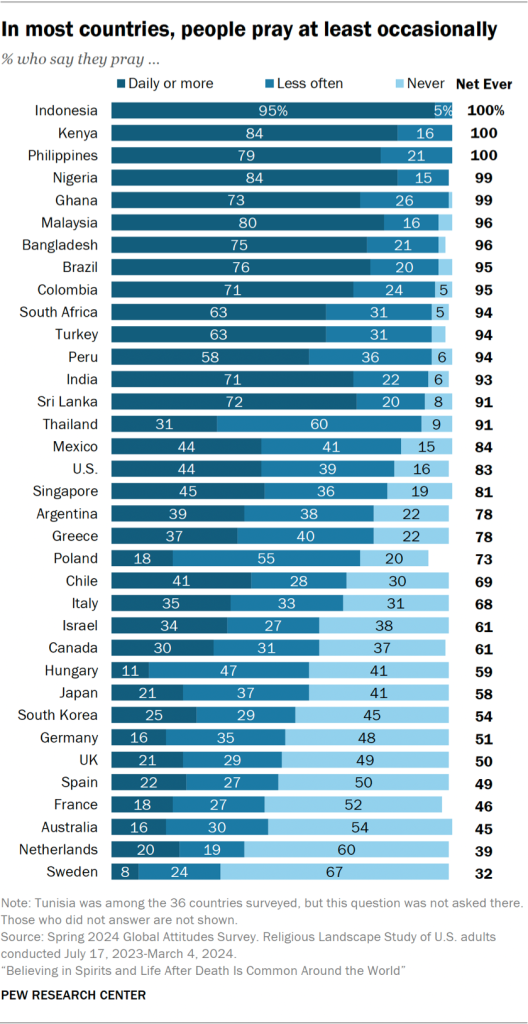
In 14 of the 35 countries surveyed, a majority of adults say they pray at least once a day. This includes 95% of Indonesians.
Other countries in South and Southeast Asia also have majorities who pray daily, as do Turkey, places in sub-Saharan Africa and parts of Latin America.
Meanwhile, in six European countries, as well as in Australia, about half or more of adults say they never pray. Swedes are the least likely among those surveyed to pray: Two-thirds of Swedish adults say they never pray.
The United States falls somewhere in the middle of the countries surveyed: 44% of U.S. adults say they pray daily, while 16% never pray.
Views by religion
In nearly every country with enough Muslims to analyze, Muslims are more likely than members of other religious groups to pray daily.
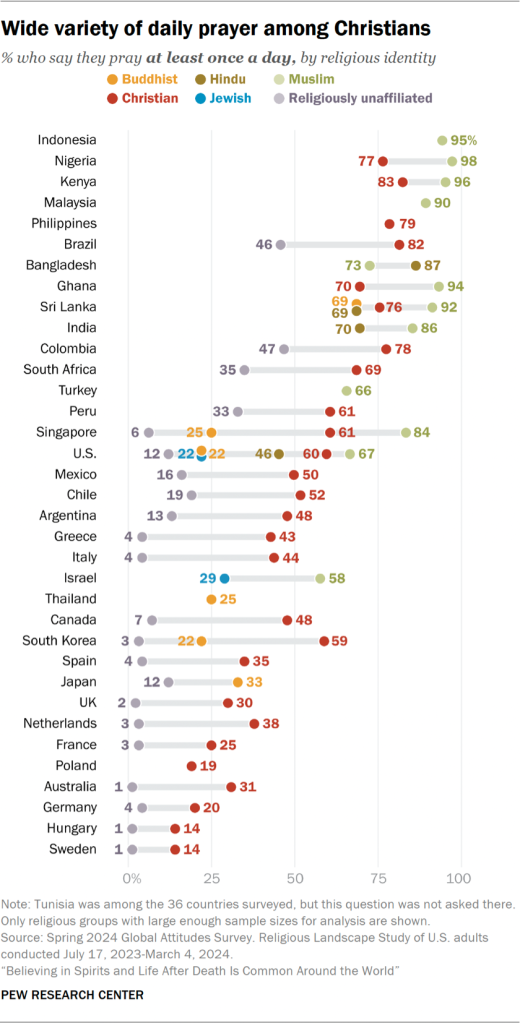
For example, 92% of Sri Lankan Muslims pray at least once a day, compared with 76% of Christians in that country and 69% of both Buddhists and Hindus.
Bangladesh is the only country where this pattern does not hold – Hindus in Bangladesh are more likely than Muslims to pray at least daily (87% vs. 73%).
In some countries, Buddhists and Jews are among the least likely to pray daily. For example, a quarter of Singaporean Buddhists pray daily, compared with 61% of Singapore’s Christians and 84% of its Muslims.
But the religiously unaffiliated are consistently the least likely to pray daily. For instance, in South Africa, 35% of unaffiliated adults say they pray daily, compared with 69% of South African Christians.
Views by age
Adults ages 50 and older are consistently more likely than the youngest adults surveyed (ages 18 to 34) to pray daily. That’s the pattern across many regions – from Europe and the Americas to Southeast Asia and East Asia.
For example, the oldest adults in Mexico are about twice as likely as the youngest adults there to pray at least daily (60% vs. 29%). Likewise, in Thailand, 39% of adults ages 50 and older say they pray daily, compared with 20% of the youngest adults.
One exception is France, where adults ages 18 to 34 are more likely than the oldest adults to pray daily (28% vs. 15%).
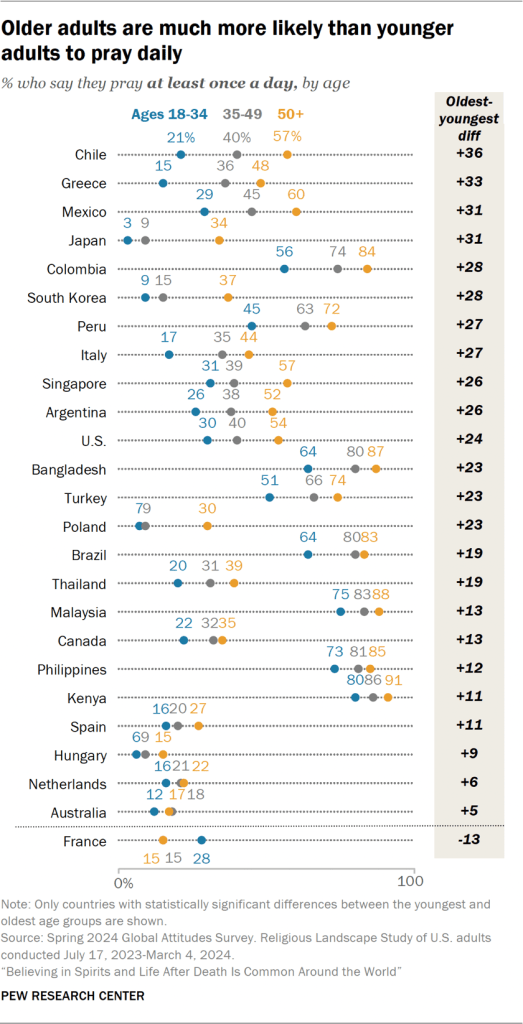
Views by gender
Like past research that generally shows women to be more religious or spiritual than men, the new survey finds that women are significantly more likely than men to say that they pray at least once a day in nearly all 35 countries surveyed.
For example, half of women in the U.S. say they pray daily, compared with 37% of men.
The only exception is Israel, where men are somewhat more likely than women to pray at least once a day (40% vs. 28%).
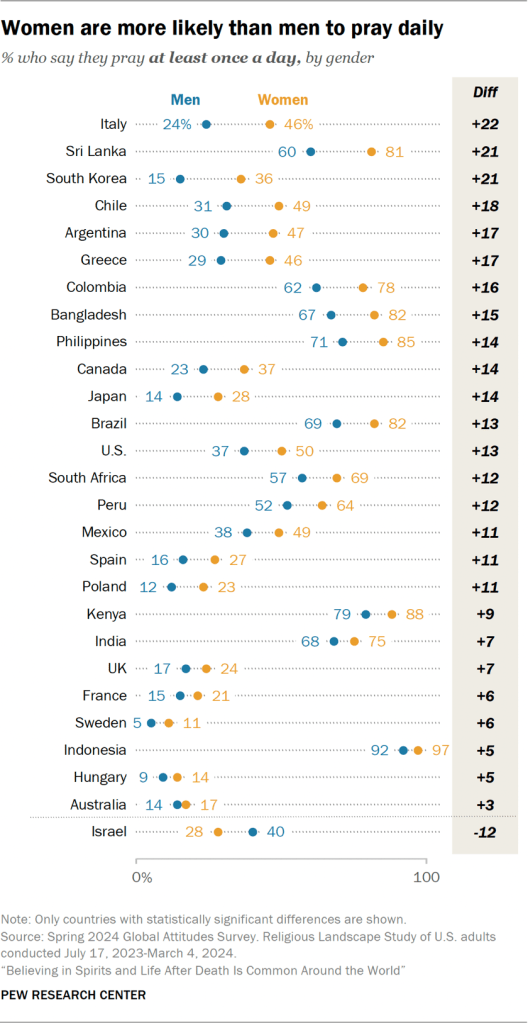
Salah among Muslims
In 11 countries with significant Muslim populations, Muslims who say that they pray several times a day were also asked if they pray five salah every day. (This question was not asked in the U.S. this time, though we asked it in a 2017 U.S. survey.)
In general, most Muslims say they pray five salah, including 91% in Nigeria and 84% in Indonesia and Sri Lanka.
Turkey is the only country surveyed where a minority of Muslims (31%) pray five salah every day.
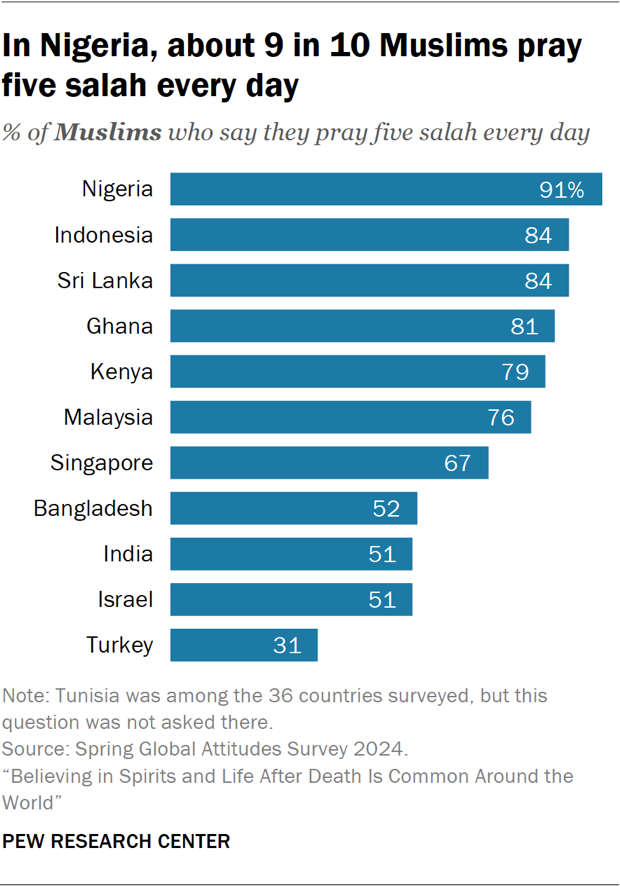
Attending religious services
In 18 of the countries surveyed, around half or more of adults say they attend a religious service or go to a house of worship once a month or more often. This includes nearly all adults in Indonesia (99%) and Nigeria (96%).
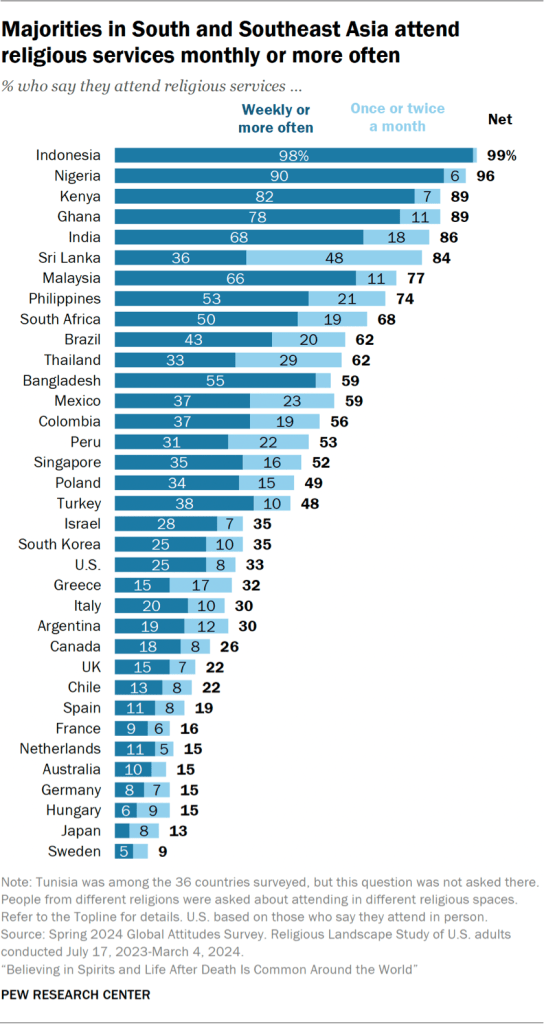
(People from different religions were asked about attending in different religious spaces. For example, Christian respondents were asked about going to church, while Hindus were asked about going to a temple. Refer to the Topline for details.)
Adults in East Asia are much less likely than those in South and Southeast Asia to be frequent attenders. For example, 13% of Japanese go to a temple or attend religious services at least once a month, while 86% of Indians do the same.
In general, most adults in sub-Saharan Africa frequent a house of worship monthly. By contrast, about one-third or fewer of European adults report being regular attenders. An exception is Poland, where about half of adults (49%) report attending religious services at least monthly.
Views by religion
Religiously unaffiliated respondents are much less likely than people who are religiously affiliated to attend services and houses of worship monthly or more often.
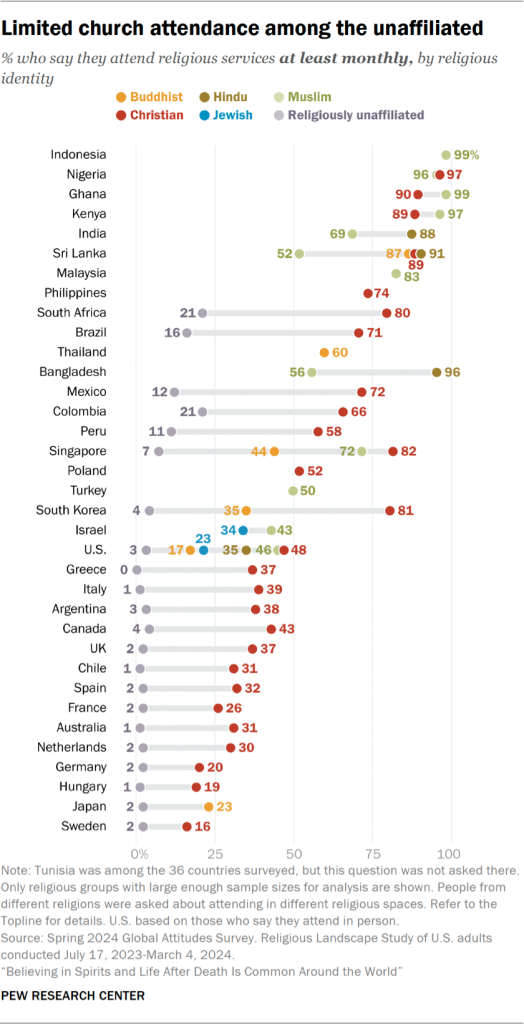
For example, 21% of unaffiliated South Africans say they attend religious services at least monthly, compared with 80% of Christians.
In three of the four countries with enough Hindus to analyze – Bangladesh, India and Sri Lanka – overwhelming majorities say they got to a temple once a month or more often.
However, attendance rates within religious groups vary considerably depending on where people live. Among Christians in Western Europe, for example, fewer than half report being regular church attenders. In Asia, about three-quarters or more of Christians say they attend church at least monthly.
Views by gender
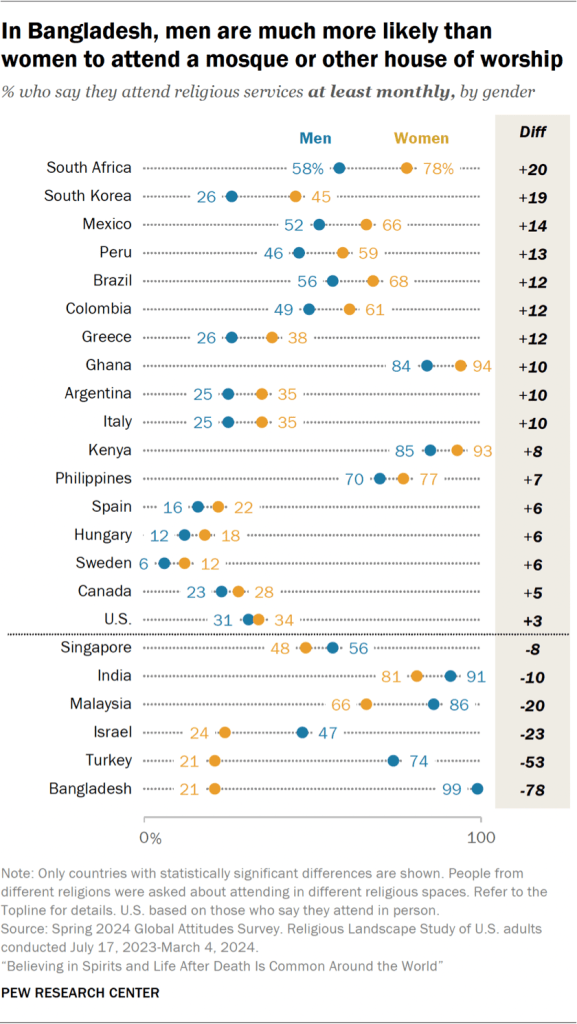
In general, women are more likely than men to attend temples, churches and other houses of worship. In both Argentina and Italy, for instance, about one-third of women say they attend religious services monthly, while a quarter of men say the same.
Yet, in a handful of the 35 countries surveyed, men are more likely than women to attend religious services – sometimes with a very large divide.
In Turkey, the gender gap between men and women is 53 percentage points. In Bangladesh, the gap is 78 points.
A previous Center report similarly found that in predominantly Christian nations, women are more likely than men to attend religious services. Yet in predominantly Muslim countries and in Israel, men attend more often than women.
Views by rate of prayer
Almost universally in the countries surveyed, people who say they pray daily are more likely than other adults to report that they attend religious services or houses of worship at least monthly.
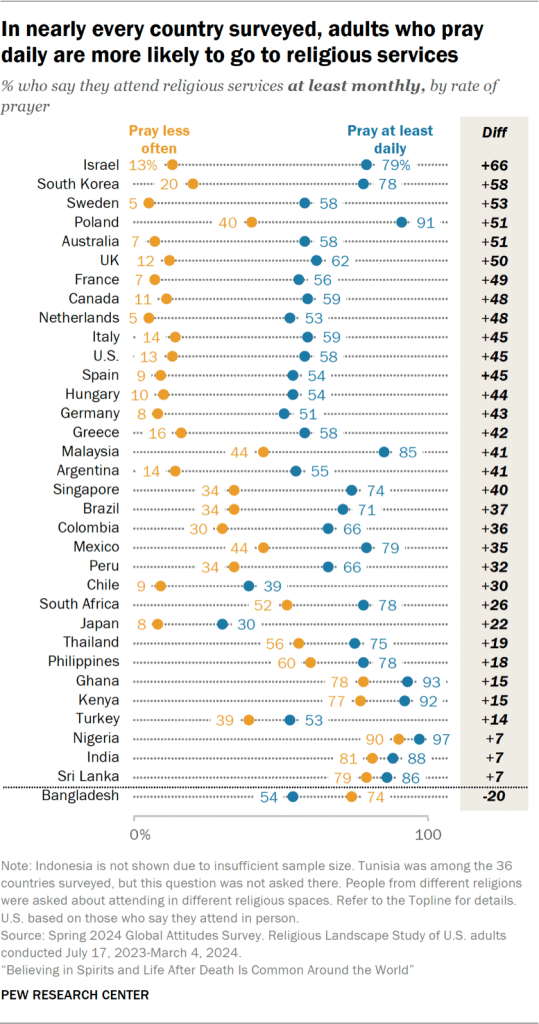
In Poland, for instance, 91% of those who pray daily say they attend religious services monthly or more often, while 40% of Poles who pray less often say they attend church at least once a month.
This pattern exists across a range of societies, from Jewish-majority Israel to Muslim-majority Malaysia, Christian-majority Mexico, and Buddhist-majority Thailand.
The only country surveyed where people who pray daily are less likely to attend worship services is Bangladesh. Some of this unique pattern is driven by Bangladeshi women being somewhat more likely than men to pray. Yet Bangladeshi men are 78 points more likely than women to go to a mosque or other religious services.
Fasting
Many religions have at least one holy period each year – such as Christian Lent or Muslim Ramadan – during which followers are expected to fast by abstaining from food, drink or various other activities.
Across the countries surveyed, the share who say they fast during holy times varies widely. Western Europeans and East Asians are generally less likely than those in other parts of Europe or Asia to fast.
For example, only 11% of Dutch and 4% of Swedes fast, while majorities of Greeks (58%) and Poles (57%) do.
In Japan, relatively few respondents say they fast for certain periods during holy times (2%), while in Bangladesh, nearly all (98%) do.
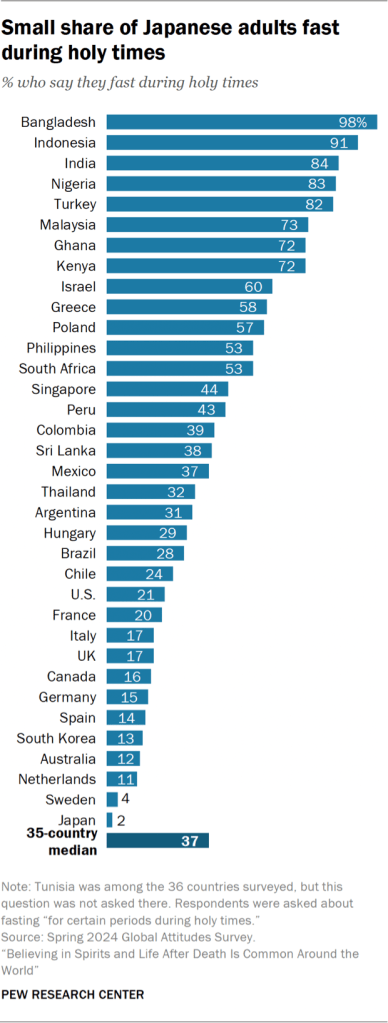
Views by religion
Muslims and Hindus are generally the most likely to say they fast.
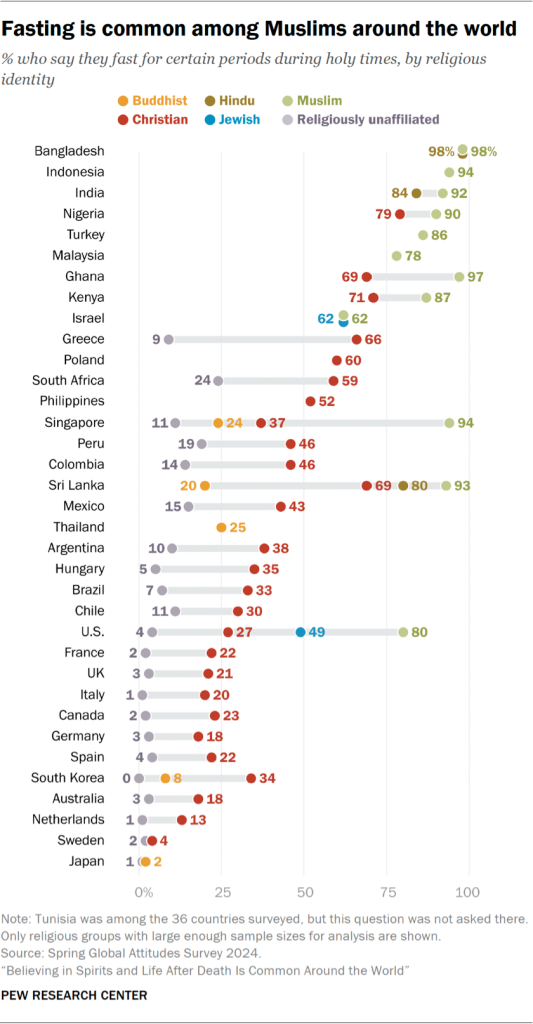
For example, in Indonesia and Ghana, nearly all Muslims fast during holy times. And in all countries with enough surveyed Muslims to analyze, majorities of Muslims say they fast.
Additionally, in all three countries with large enough samples of Hindus – Bangladesh, India and Sri Lanka – at least eight-in-ten Hindus fast.
In Israel, 62% of Jews say they fast during holy periods.
Christian fasting rates vary considerably from country to country, ranging from 79% in Nigeria to 13% in the Netherlands.
Views by age
In more than a dozen of the 35 countries surveyed, adults ages 50 and older are more likely than adults ages 18 to 34 to fast during holy times.
Almost half of the oldest Colombian adults, for instance, say they fast for certain periods during holy times. By contrast, 29% of the youngest adults surveyed say this.
However, in five countries – Australia, Canada, France, Germany and the United Kingdom – younger adults are more likely than older adults to fast.
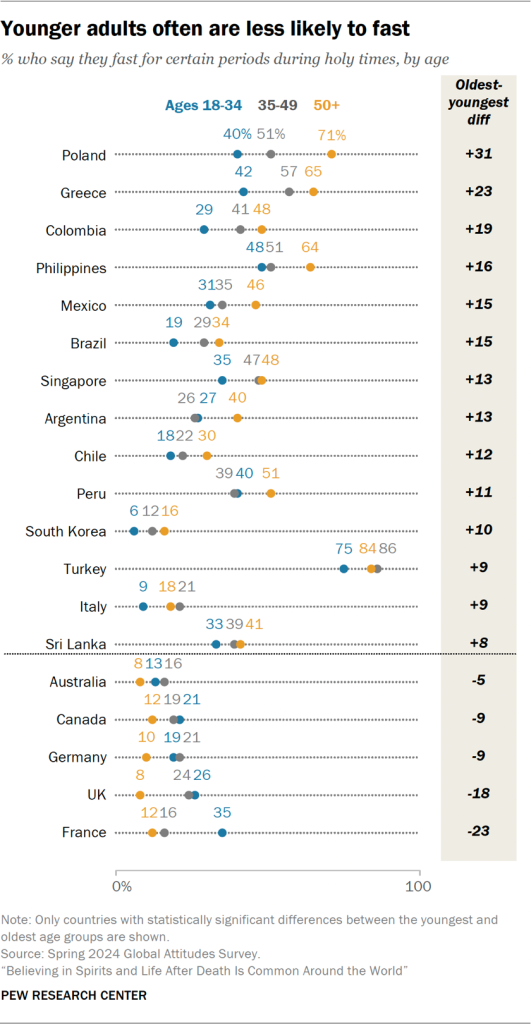
Lighting incense and candles
Fewer than half of adults in most countries surveyed say they light incense or candles for spiritual or religious reasons.
Only in five countries do a majority of the public say they light candles or incense: India (91%), Thailand (73%), Sri Lanka (70%) the Philippines (65%) and South Africa (63%).
Conversely, about one-quarter of adults in Hungary and Spain engage in this practice. Two-in-ten Canadians and Americans light candles or incense for spiritual reasons.
People in Indonesia (10%) and Turkey (8%) are among the least likely to light incense or candles for these purposes.
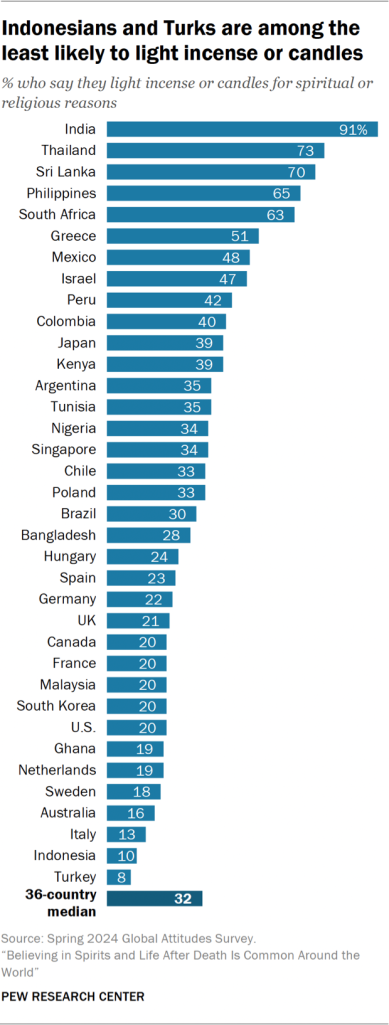
Views by religion
Large majorities of Hindus say they light incense or candles for spiritual or religious reasons, including 100% in Bangladesh and 95% in India.
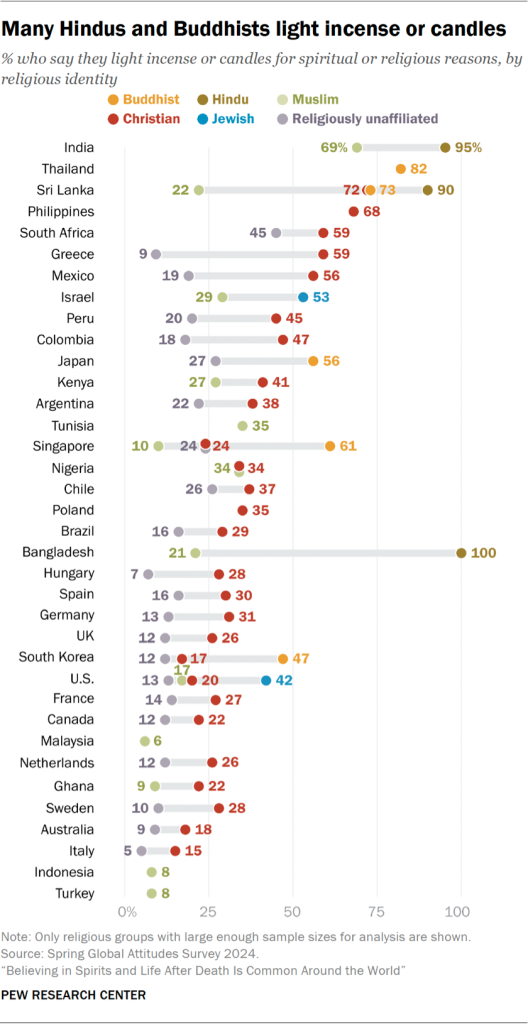
In most countries with sufficient sample size to analyze the Buddhist population, many Buddhists also light candles or incense.
Christians around the world vary widely in their religious use of incense and candles, ranging from 72% in Sri Lanka to 15% in Italy.
In nearly all surveyed countries with enough Muslims to analyze, fewer than half of Muslims say they follow this practice. However, 69% of Indian Muslims light incense or candles for spiritual or religious reasons.
Around half of Jewish Israelis (53%), as well as 42% of Jewish Americans, light candles for religious or spiritual reasons. These are the only two countries with sufficiently large samples of Jews to analyze their attitudes and behaviors.
Views by education
In some countries, adults who have less education are more likely than others to say that they light incense or candles.
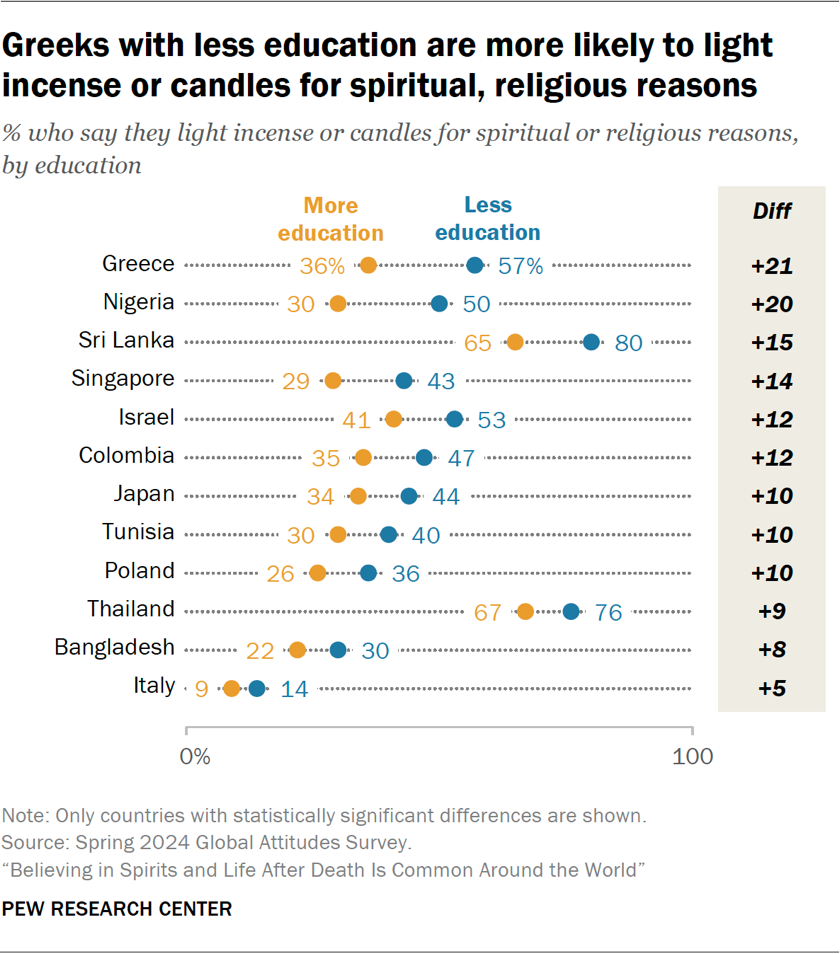
For example, a majority of Greek adults who have lower levels of education (57%) say they light either candles or incense, while about one-third of Greeks with higher levels of education (36%) say that they follow this practice.
And in Nigeria, half of adults who have lower levels of education light incense or candles for spiritual or religious reasons, while three-in-ten of those with higher levels of education say they do this.
(To compare educational groups across countries, we standardize education levels based on the United Nations’ International Standard Classification of Education. In Greece, adults with lower levels of education have completed secondary school or less. In Nigeria, adults with lower levels of education have not completed secondary school.)
Wearing religious symbols
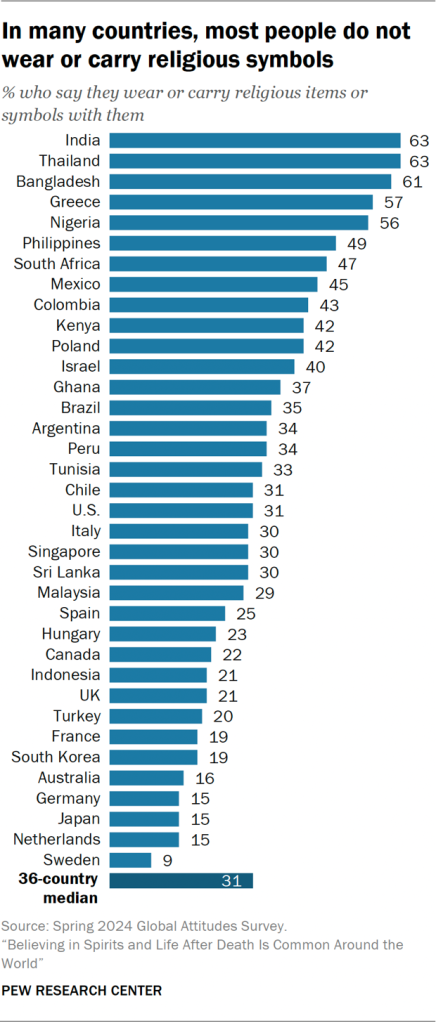
Religions often have symbols some followers choose to wear or carry with them, such as a Jewish Star of David or a Hindu tilak.
However, in only a handful of the surveyed countries do a majority say they wear or carry religious symbols or items with them.
This practice is most common in the South and Southeast Asian countries of Bangladesh, India and Thailand. Yet in several neighboring countries – Malaysia, Singapore and Sri Lanka – adults are much less likely to wear or carry religious symbols.
A similar divide is seen in Europe. Though most Europeans do not wear religious symbols, Greek adults are among the most likely in this survey to say they do so.
Views by religion
Fewer than one-quarter of religiously unaffiliated adults in every country surveyed say that they wear or carry symbols.
Meanwhile, majorities of Hindus in Bangladesh (93%), India (66%) and Sri Lanka (59%) wear or carry religious items or symbols.
And about four-in-ten Jewish adults in both Israel (42%) and the U.S. (38%) say that they do this.
Within some other religious groups, responses to this question vary widely by location. For example, 70% of Buddhists in Thailand wear or carry a religious symbol, compared with about one-in-five Buddhists in Sri Lanka (22%) and Japan (20%) who do the same.
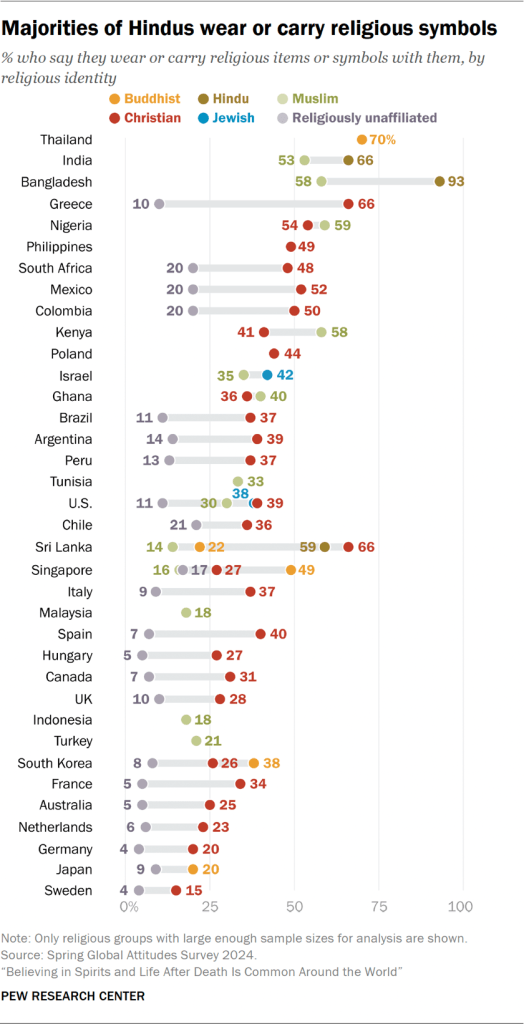
Views by gender
In many of the high-income countries surveyed, women are more likely than men to wear or carry religious items. In the U.S., for instance, 36% of women say they do this, compared with 24% of men.
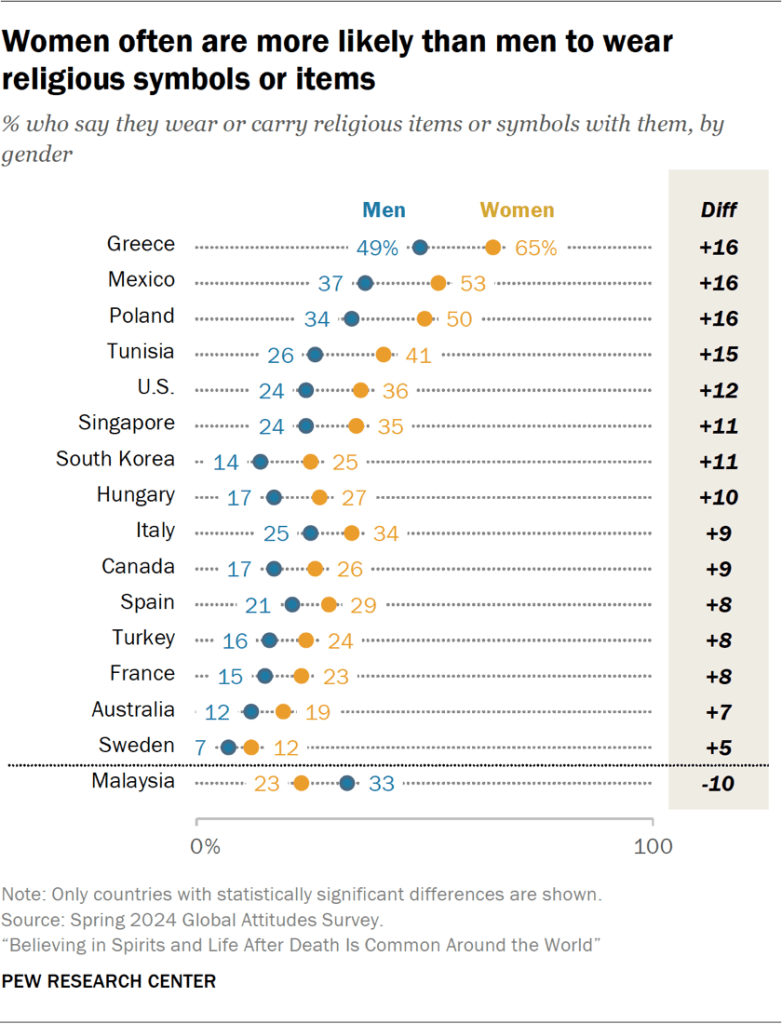
This gender divide is also present in the middle-income countries of Mexico, Tunisia and Turkey.
Malaysian men, however, are more likely than Malaysian women to wear or carry religious items or symbols with them (33% vs. 23%).




